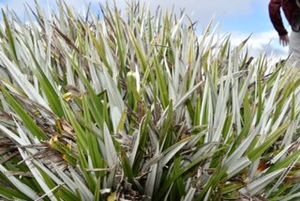Astelia alpina facts for kids
Quick facts for kids Astelia alpina |
|
|---|---|
 |
|
| Astelia alpina at the summit of Mount Wellington | |
| Scientific classification | |
| Genus: |
Astelia
|
| Species: |
alpina
|
Astelia alpina, often called pineapple grass, is a cool plant found in the mountains of Tasmania and the Australian Alps. It also goes by names like silver astelia or perching lily. This plant lives for many years and grows in thick clumps, like a mat, especially in wet, marshy areas high up in the mountains.
There are two main types, or subspecies, of pineapple grass. One is found in New South Wales and Victoria, and the other is only found in Tasmania. They look very much alike. A famous botanist named Robert Brown first described this plant.
Contents
What Does Pineapple Grass Look Like?
Pineapple grass has green leaves that look a bit like a pineapple plant's leaves. The underside of its leaves is silvery and fuzzy. These leaves can grow up to 30 centimeters long and 2-3 centimeters wide. They get narrower at the end and feel stiff.
The top of the leaf is green, but the bottom has many tiny white hairs. Under a microscope, you can see these hairs have special cells at their base. The flowers of pineapple grass are small and a mix of white and green. When the plant has fruit, they are red, oval-shaped, and about 12mm long. These fruits are soft and you can eat them! Male plants have more flowers than female plants.
What's in a Name?
The name Astelia comes from an old Greek word. It means "without a trunk," because the plant has a very short stem. Alpina comes from Latin and means "from the Alps" or "high mountains." This makes sense because that's where it likes to grow!
People usually call it pineapple grass because its leaves look like a pineapple plant. But it's also known as silver astelia or perching lily. Even though it's called "grass," it's not a true grass. It's actually more closely related to the lily family.
Scientists are still studying how different Astelia plants are related. Recent studies show that the Tasmanian type of pineapple grass might be as closely related to some other Astelia species from places like New Guinea as it is to the type found in New South Wales and Victoria.
How Does Pineapple Grass Reproduce?
Pineapple grass flowers appear in the summer. This plant is special because it is dioecious. This means that each plant has either male flowers or female flowers, but not both. So, you need both a male and a female plant for seeds to form.
Like other Astelia plants that grow in wet places, the female flower has a sticky substance. This sticky stuff helps the pollen move from the male flowers to the female flowers. Humans can also help new plants grow. You can carefully break apart a big clump of pineapple grass and plant the pieces separately. Male plants usually produce more flowers than female plants.
Where Does Pineapple Grass Grow?
You can find pineapple grass in the high mountain areas of Tasmania and the Australian Alps. Plants that live here need to be very tough! They have to survive strong winds, hot sun in summer, and freezing cold in winter.
In Tasmania, this plant often takes over wet, grassy areas in the mountains. You can find it on all of Tasmania's mountains. It likes wet soil and often grows with other mountain plants. These include the coral fern (Gleichenia alpina), Empodisma minus, Carpha alpina, and Restio australis.
How Pineapple Grass Helps the Environment
Pineapple grass is often one of the first plants to grow back after a fire in mountain areas. About 10 to 20 years after a fire, pineapple grass often becomes the main plant in these wet, grassy areas. It usually replaces other types of bushy plants that were there before.
The way pineapple grass grows and how much it covers the ground can change depending on where it is. For example, in some places, it grows in big, strong clumps, while in others, it might be more spread out and shorter.
| Location | Height Above Sea Level | What the Plant Looks Like | How Much it Covers |
|---|---|---|---|
| Wombat Moor, Mt Field National Park, Tasmania | 1070m | Strong clumps of pineapple grass growing up to 60 cm tall. | Covers about 40% of the ground, sharing space with coral fern. |
| Hansons Peak, Cradle Mountain National Park, Tasmania | 1185m | Thin clumps of pineapple grass growing up to 15 cm tall. | Covers about 10% of the ground. Coral fern is more common here. |
| Ladies Tarn, Mt Hartz National Park, Tasmania | 979m | Thick clumps of pineapple grass growing up to 40 cm tall. | Covers about 30% of the ground, mixed with coral fern and other shrubs. |
Is Pineapple Grass in Danger?
No, pineapple grass is not considered to be at risk of disappearing in the wild. However, the mountain areas where it grows are important. These areas are most threatened by fires and by people walking through them.
Uses of Pineapple Grass
Pineapple grass is not grown very often by people. But its red berries are safe to eat! This plant likes to grow in high places with wet soil and lots of sunlight. If you want to grow it in lower areas, it does better in colder climates. You can also collect seeds from wild plants.
An old book from 1889, called 'The Useful Native Plants of Australia', says that "The fruit is sweet, and the bases of the leaves are eaten."
See Also


